|
|
市場調査レポート
商品コード
1570635
欧州のデータセンター用冷媒市場:製品別、用途別、国別 - 分析と予測(2023年~2032年)Europe Data Center Refrigerant Market: Focus on Product, Application, and Country - Analysis and Forecast, 2023-2032 |
||||||
カスタマイズ可能
|
|||||||
| 欧州のデータセンター用冷媒市場:製品別、用途別、国別 - 分析と予測(2023年~2032年) |
|
出版日: 2024年10月17日
発行: BIS Research
ページ情報: 英文 97 Pages
納期: 1~5営業日
|
全表示
- 概要
- 図表
- 目次
欧州のデータセンター冷媒の市場規模(英国を除く)は、2023年の1億1,650万米ドルから2032年には2億1,080万米ドルに成長すると予測され、予測期間の2023年~2032年のCAGRは6.1%になるとみられています。
データセンター数の増加とエネルギー効率の高い運用を奨励する政府プログラムは、欧州のデータセンター用冷媒市場の拡大を促進すると予想されます。さらに、持続可能性の目標を支援するため、欧州全域で財政的インセンティブと規制の枠組みがデータセンター施設に環境に優しい冷媒の使用を促しています。
| 主要市場統計 | |
|---|---|
| 予測期間 | 2023年~2032年 |
| 2023年の評価 | 1億1,650万米ドル |
| 2032年の予測 | 2億1,080万米ドル |
| CAGR | 6.1% |
欧州のデータセンター用冷媒市場は、さまざまな産業でデータ処理と保存のニーズが高まっていることから、大幅な拡大が見込まれています。欧州ではデータセンターの数が増加しているため、ピーク性能を維持しダウンタイムを減らすために、効果的な冷却ソリューションへの需要が高まっています。サーバーやその他の機器を安全な温度範囲内で稼働させるため、冷媒はデータセンターの冷却に不可欠です。
環境に配慮し、エネルギー効率の高いデータセンター運営を目指す動向は、市場を推進する主な要因の一つです。この地域の大きな持続可能性の目的に沿って、欧州各地の政府は厳しい規則を施行し、環境に優しい冷媒の使用を奨励する財政的インセンティブを提供しています。フッ素系ガスの環境負荷低減を目指す欧州連合のFガス規制などの政策が、データセンター事業者に低GWP(地球温暖化係数)冷媒の採用を促しています。
また、冷却技術の新興国における市場開拓や、エネルギー使用量の削減が重視されるようになったことも、市場を後押ししています。データセンターでは、特定の冷媒を必要とする液体冷却システムやハイブリッド冷却システムの導入が進んでおり、独創的で環境に優しい冷却ソリューションへのニーズが高まると予測されます。欧州のデータセンター用冷媒市場の将来は、おそらくこの動向によって形作られることになるとみられています。
当レポートでは、欧州のデータセンター用冷媒市場について調査し、市場の概要とともに、製品別、用途別、国別の動向、および市場に参入する企業のプロファイルなどを提供しています。
目次
エグゼクティブサマリー
第1章 市場
- 業界展望
- エコシステム/進行中のプログラム
- ビジネスダイナミクス
- サプライチェーン分析
- 価格分析
第2章 地域
- 世界のデータセンター市場見通し
- 欧州
- 英国
第3章 市場-競合ベンチマーキングと企業プロファイル
- 競合ベンチマーキング
- 企業プロファイル
- Climalife
- Arkema
- M&I Materials Ltd
- Asetek, Inc. A/S
第4章 調査手法
List of Figures
- Figure 1: Properties of Hydrogen, Fluorine, and Chlorine Refrigerants
- Figure 2: Phase-Out Schedules for HCFCs and HFCs
- Figure 3: Europe Data Center Refrigerant Market, $Million, 2022-2032
- Figure 4: Europe Data Center Refrigerant Market (by Industry), $Million, 2022 and 2032
- Figure 5: Europe Data Center Refrigerant Market (by Data Center Type), $Million, 2022 and 2032
- Figure 6: Europe Data Center Refrigerant Market (by Refrigerant Type), $Million, 2022 and 2032
- Figure 7: Europe Data Center Refrigerant Market (by Cooling Type), $Million, 2022 and 2032
- Figure 8: Europe Data Center Refrigerant Market (by Deployment), $Million, 2022 and 2032
- Figure 9: Data Center Refrigerant Market (by Region), 2022
- Figure 10: Hyperscale Data Center Capacity (by Region), MW, 2021
- Figure 11: Data Center Capacity Outlook (by Region), MW, 2021
- Figure 12: Anticipated Energy Consumption, by Data Center Types, TWh, 2023
- Figure 13: Power Flows in a typical Data Center:
- Figure 14: Pathway to Carbon Neutrality in Data Centers
- Figure 15: Key Factors for Assessing Infrastructure Cost in a Data Center Project
- Figure 16: CAPEX Comparison: Traditional Data Centers (TDC) Vs Carbon Neutral Data Centers (CNDC)
- Figure 17: Key Factors for Assessing Energy Cost in Data Center Project
- Figure 18: OPEX Comparison: Traditional Data Centers (TDC) Vs Carbon Neutral Data Centers (CNDC):
- Figure 19: Major Countries' Share of Total Installed Renewable Capacity, 2021
- Figure 20: Global Trend in Industrial Refrigeration
- Figure 21: Estimated Capital Expense for Various Data Center Cooling Technologies
- Figure 22: Some Criteria Followed by Data Centers while Choosing Refrigerants
- Figure 23: GWP and ODP of Most Common Refrigerants in Data Centers
- Figure 24: Estimated Worldwide 5G Adoption as a Share of Total Mobile Connections (Excluding IoT)
- Figure 25: Share of Data Center (by Country), 2022
- Figure 26: Water Utility and Wastewater Cost Comparison in Data Centers, 2021
- Figure 27: Cooling Efficiency and Water Usage of Data Center Cooling Technologies
- Figure 28: Energy Distribution in a Typical Data Center, 2022
- Figure 29: Evolution of Refrigerants from 1830 and Future Anticipations
- Figure 30: Data Center Web Traffic, Zettabytes per Year, 2016-2021
- Figure 31: Data Center pPue Analysis
- Figure 32: Supply Chain Analysis of Data Center Refrigerant Market
- Figure 33: Competitive Benchmarking Matrix
- Figure 34: Data Center Refrigerant Market: Research Methodology
- Figure 35: Data Triangulation
- Figure 36: Top-Down and Bottom-Up Approach
- Figure 37: Assumptions and Limitations
List of Tables
- Table 1: Advantages and Disadvantages of Non-PFAS Refrigerants
- Table 2: Key Consortium/Association in Data Center Refrigerant Industry
- Table 3: Regulations Impacting the Data Center Refrigerant Market
- Table 4: Government Initiatives and Impacts
- Table 5: Recent Developments by Leading Companies toward Data Center Cooling, 2019-2023
- Table 6: Key Companies and Developments toward Neural Networks in Data Centers
- Table 7: Key Companies Exploring Indirect Thermosyphon Cooling
- Table 8: Data Center Refrigerant Pricing
- Table 9: Data Center Refrigerant Market (by Region), $Million, 2022-2032
- Table 10: Climalife: Product Portfolio
- Table 11: Arkema: Product Portfolio
- Table 12: M&I Materials Ltd: Product Portfolio
- Table 13: Asetek, Inc. A/S: Product Portfolio
Introduction to Europe Data Center Refrigerant Market
The Europe data center refrigerant market (excluding U.K.) is expected to grow from $116.5 million in 2023 to $210.8 million by 2032, at a CAGR of 6.1% during the forecast period 2023-2032. The rising number of data centers and government programs encouraging energy-efficient operations are anticipated to propel the expansion of the European data center refrigerant market. Additionally, in support of sustainability objectives, financial incentives and regulatory frameworks throughout Europe are pushing data center facilities to use eco-friendly refrigerants.
Market Introduction
| KEY MARKET STATISTICS | |
|---|---|
| Forecast Period | 2023 - 2032 |
| 2023 Evaluation | $116.5 Million |
| 2032 Forecast | $210.8 Million |
| CAGR | 6.1% |
A major expansion of the European data center refrigerant market is anticipated due to the growing need for data processing and storage in a variety of industries. The increasing number of data centers in Europe has led to an increased demand for effective cooling solutions in order to sustain peak performance and reduce downtime. To keep servers and other equipment operating within safe temperature ranges, refrigerants are essential to the cooling of data centers.
The trend toward environmentally responsible and energy-efficient data center operations is one of the main forces propelling the market. In line with the region's larger sustainability aims, governments around Europe are enforcing strict rules and providing financial incentives to encourage the use of eco-friendly refrigerants. Policies such as the European Union's F-Gas Regulation, which aims to reduce the environmental impact of fluorinated gases, are pushing data center operators to adopt low-global-warming-potential (GWP) refrigerants.
The market is also being helped by developments in cooling technology and the increased emphasis on lowering energy usage. The need for creative and environmentally friendly cooling solutions is predicted to increase as data centers install more liquid and hybrid cooling systems, which need for specific refrigerants. The future of the European data center refrigerant market is probably going to be shaped by this trend.
Market Segmentation
Segmentation 1: by Industry
- IT and Telecom
- Banking
- Financial Services and Insurance (BFSI)
- Research and Healthcare
- Retail
- Manufacturing
- Others
Segmentation 2: by Data Center Type
- Hyperscale
- Colocation
- Edge Data Center
- Enterprise
Segmentation 3: by Refrigerant Type
- Conventional Refrigerants
- Liquid Cooling Fluids
Segmentation 4: by Cooling Type
- Air Cooling
- Liquid Cooling
- Free Cooling
Segmentation 5: by Deployment
- Installation/OEM
- Aftermarket
Segmentation 6: by Country
- Germany
- Netherlands
- France
- Scandinavia
- Rest-of-Europe
How can this report add value to an organization?
Product/ Innovation Strategy: In the Europe data center refrigerant market, a strategic focus on innovation drives product development. Collaborate with industry leaders to introduce eco-friendly refrigerants and advanced cooling technologies, meeting evolving regulatory standards. Leverage data analytics for real-time monitoring, optimizing cooling efficiency, and reducing environmental impact while ensuring operational excellence.
Growth/ Marketing Strategy: Utilize targeted marketing campaigns highlighting eco-friendly benefits and energy savings. Forge partnerships with data center operators and OEMs to expand reach and offer comprehensive solutions. Continuously innovate to stay ahead in the competitive landscape.
Competitive Strategy: Emphasizing differentiation and value proposition will be crucial for success in the market. Conduct thorough market analysis to identify niche segments and competitive advantages and position products accordingly. Forge alliances with key stakeholders and offer customizable solutions to meet diverse customer needs effectively.
Key Market Players and Competition Synopsis
The companies that are profiled in the Europe data center refrigerant market have been selected based on inputs gathered from primary experts and analyzing company coverage, product portfolio, and market penetration.
Some of the prominent names in the market are:
- Climalife
- Arkema
- M&I Materials Ltd
- Asetek, Inc. A/S
Table of Contents
Executive Summary
1 Markets
- 1.1 Industry Outlook
- 1.1.1 Market Definition
- 1.1.2 Data Center Trends
- 1.1.2.1 Data Center Capacities: Current and Future
- 1.1.2.2 Data Center Power Consumption Scenario
- 1.1.2.3 Impact of Carbon-Neutral Data Center (CNDC) Operations on Data Center Refrigerant Market
- 1.1.2.3.1 Current and Future Scenario for CNDC
- 1.1.2.3.2 Alternative Solutions to Current HVAC Systems Used in Data Centers
- 1.1.2.3.3 Cost Analysis
- 1.1.2.3.3.1 Capital Expenditure (CAPEX)
- 1.1.2.3.3.1.1 Infrastructure Cost
- 1.1.2.3.3.2 Operational Expenditure (OPEX)
- 1.1.2.3.3.2.1 Energy Cost
- 1.1.2.3.4 Key Countries to Focus
- 1.1.2.4 Impact of United Nations Intergovernmental Panel on Climate Change on Data Center Market
- 1.1.2.4.1 Impact Assessment of United Intergovernmental Panel on Climate Change (IPCC)'s report
- 1.1.2.5 Impact of PFAS Refrigerant Ban on the Data Center Cooling Outlook
- 1.1.2.5.1 Alternative Cooling Solutions to PFAS Refrigerants
- 1.1.2.5.2 Advantages and Disadvantages of Non-PFAS Refrigerants
- 1.1.2.6 Data Center Cooling Strategies
- 1.1.2.6.1 Upcoming Data Center Refrigerant Concepts
- 1.1.2.7 Refrigerant Selection Criteria
- 1.1.2.8 Other Industrial Trends
- 1.1.2.8.1 HPC Cluster Developments
- 1.1.2.8.2 Blockchain Initiatives
- 1.1.2.8.3 Super Computing
- 1.1.2.8.4 5G and 6G Developments
- 1.1.2.8.5 Impact of Server/Rack Density
- 1.2 Ecosystem/Ongoing Programs
- 1.2.1 Consortiums and Associations
- 1.2.2 Important Regulations
- 1.2.3 Government Initiatives and Impacts
- 1.3 Business Dynamics
- 1.3.1 Business Drivers
- 1.3.1.1 Expanding Data Center Industry
- 1.3.1.1.1 Data Center Investment Landscape
- 1.3.1.1.1.1 Key Regional Data Center Investment Trend (2022-2023)
- 1.3.1.1.1 Data Center Investment Landscape
- 1.3.1.2 Sustainable Development Efforts and CSR Activities
- 1.3.1.2.1 The Green IT Cube
- 1.3.1.3 Growing Adoption of Alternate Cooling Solutions for Improved Water Usage Efficiency
- 1.3.1.4 Need for High Energy Efficiency
- 1.3.1.1 Expanding Data Center Industry
- 1.3.2 Business Challenges
- 1.3.2.1 Phasing out of PFAS Refrigerants
- 1.3.2.2 Intense Market Competition from Diverse Cooling Technology
- 1.3.2.3 Rapid Adoption of Refrigerants over Air Cooling Driven by its Advantages
- 1.3.2.3.1 Leading Hyperscale Data Centre Operators to Have a Huge Impact on Market Adoption
- 1.3.3 Business Opportunities
- 1.3.3.1 AI and Neural Network Implementation to Optimize Cooling
- 1.3.3.2 Growing Traction for Indirect Thermosyphon Cooling
- 1.3.3.3 Increase in Investments toward Data Center Cooling Innovations
- 1.3.3.4 Growing Utilization of Advanced Refrigerants to Meet Environmental Targets
- 1.3.3.5 Resurgence of Air-Cooled Chillers
- 1.3.1 Business Drivers
- 1.4 Supply Chain Analysis
- 1.5 Pricing Analysis
2 Regions
- 2.1 Global Data Center Outlook
- 2.2 Europe
- 2.2.1 Germany
- 2.2.2 Netherlands
- 2.2.3 France
- 2.2.4 Scandinavia
- 2.2.5 Rest of Europe
- 2.3 U.K.
3 Markets - Competitive Benchmarking & Company Profiles
- 3.1 Competitive Benchmarking
- 3.2 Company Profiles
- 3.2.1 Climalife
- 3.2.1.1 Company Overview
- 3.2.1.2 Product Portfolio
- 3.2.1.3 Analyst View
- 3.2.1.3.1 Regions of Growth:
- 3.2.2 Arkema
- 3.2.2.1 Company Overview
- 3.2.2.2 Product Portfolio
- 3.2.2.3 Analyst View
- 3.2.2.3.1 Regions of Growth:
- 3.2.3 M&I Materials Ltd
- 3.2.3.1 Company Overview
- 3.2.3.2 Product Portfolio
- 3.2.3.3 Customer Profile
- 3.2.3.3.1 Target Customer Segments
- 3.2.3.4 Analyst View
- 3.2.3.4.1 Regions of Growth:
- 3.2.4 Asetek, Inc. A/S
- 3.2.4.1 Company Overview
- 3.2.4.2 Product Portfolio
- 3.2.4.3 Customer Profile
- 3.2.4.3.1 Target Customer Segments
- 3.2.4.4 Analyst View
- 3.2.4.4.1 Regions of Growth:
- 3.2.1 Climalife
4 Research Methodology
- 4.1 Data Sources
- 4.1.1 Primary Data Sources
- 4.1.2 Secondary Data Sources
- 4.1.3 Data Triangulation
- 4.2 Market Estimation and Forecast
- 4.2.1 Factors for Data Prediction and Modelling





